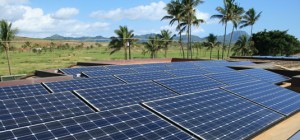 Hawaii leads all states in rooftop solar adoption, and the state has the most aggressive renewables goal in the country, with a target of 100% renewables by 2045. But paradoxically, Hawaii’s regulators just ended the policy that has led to high levels of rooftop solar uptake: net metering.
Hawaii leads all states in rooftop solar adoption, and the state has the most aggressive renewables goal in the country, with a target of 100% renewables by 2045. But paradoxically, Hawaii’s regulators just ended the policy that has led to high levels of rooftop solar uptake: net metering.
Net metering is what most states use to encourage distributed renewables. Customers don’t get cash for any energy they generate on-site but instead get a retail credit on their bill for any surplus power they generate and don’t use on-site. In Hawaii, it’s been a great deal, because electricity rates are ridiculously high, as they generate electricity from burning imported diesel. And of course sunshine abounds there.
But the policy is no more:
The PUC said nothing will change for existing net metering customers, nor those who submitted applications for the program before Monday. But those who submitted the applications afterwards will have to choose two new options when installing solar.
The self-supply option — a non-export option — allows a limited amount of inadvertent energy exportation to the grid without any compensation. Residential customers who choose this option will have a minimum bill of $25, while small commercial customers will have a $50 minimum bill.
The grid-supply option will open the door for exporting excess energy to the grid for credits against customer bills so long as the exports benefit the electric system. While similar to net metering, this option does not credit customers at the retail rate. Instead, the new grid-supply programs credits customers at a fixed rate between $0.15/kWh to $0.28/kWh, depending on the island on which they are located.
My guess is that these two options will still provide economic incentive for many Hawaii customers to go solar, just given how expensive electricity is there (typically in the 30 cents per kilowatt hour range or more). But not as much incentive, and therefore there will be less rooftop solar. And I’m dubious about utility doom-and-gloom claims that the existing amount of rooftop solar is putting grid reliability and affordability in jeopardy.
But in the long run, we know rooftop solar incentives everywhere will start to head in this direction. California regulators are already in the process of revamping and scaling back net metering incentives here, per a 2013 state law. My hope is that costs will come down on solar, both in terms of hardware and soft costs, to offset some of the incentive decreases and that the new rates will encourage energy storage purchases, such as home batteries.
But I don’t see that energy storage incentive built in to Hawaii’s two new options, which is troubling. There ought to be an incentive to encourage supply of renewables at key times, which batteries can do. In other words, we need to reward customers for supplying steady and well-timed solar power to the grid.
Ultimately, we’ll need to encourage everyone to purchase both solar and storage, and smart rate design should find the sweet spot between those two. Hawaii would be a great place to start figuring that out.
2 thoughts on “Future Of Rooftop Solar May Be In Hawaii Right Now”
-
Pingback: Hawaii’s “Postcard From The Future” On How To Pay For Rooftop Solar | Ethan Elkind
-
Pingback: Rooftop Solar’s Competing Future: Nevada Vs. Hawaii | Ethan Elkind
Leave a Reply
You must be logged in to post a comment.


